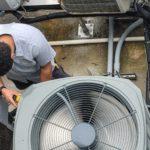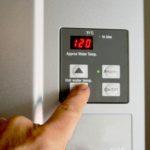Natural gas furnaces are an efficient way to provide fast and evenly distributed heat throughout your entire home. If you live in a cold northern climate, it’s one of the most effective heating systems available. But because these furnaces use natural gas for fuel, their cost efficiency can change as gas prices fluctuate.
According to the Associated Press, winter heating bills are expected to rise as natural gas prices increase. We’ll take a closer look at why heating costs are on the rise, and how you can take steps to keep your home’s heating system energy efficient.
Why Have Natural Gas Prices Gone Up?
While heating costs always go up as the weather cools down, this winter’s energy bills are expected to be higher than usual. This is because of several factors including:
- Winter temperatures in the U.S. are forecasted to be colder than average. This is common during La Niña climate patterns, primarily for the Northeast and Midwest.
- Global inflation rates are going up. As the economy steadily winds back up, stumbling supply chains are put under even more strain. This pushes up prices at a faster pace.
Did you know that nearly half of U.S. homes count on natural gas for their central heating? With so many homeowners facing higher heating bills, an energy-efficient HVAC system is more important than ever.
Maximize Your Home’s Energy Efficiency
Your home’s energy efficiency is primarily influenced by your HVAC system, as heating and cooling account for close to half your monthly energy costs. Investing in a quality gas furnace goes a long way, but there are other options for improving your home’s energy efficiency. To keep heating costs more manageable this year, check out these cost-cutting tips.
1. Invest in a Smart Thermostat
Smart thermostats are a type of programmable thermostat with features designed to help your HVAC system perform more efficiently. With Wi-Fi connectivity, you can alter the temperature from every room in the house. In fact, many smart thermostats can be remotely controlled from your smartphone or tablet! You no longer have to worry about wasted energy if you were unable to adjust the thermostat before leaving for work or vacation.
Smart thermostats monitor how you use your HVAC system and will apply that information to optimize your preferred day-to-day heating and cooling schedule. For example, if you prefer a warm bedroom when you wake up, a smart thermostat can automatically turn up the heat every morning.
To encourage more homeowners to install smart thermostats, many energy companies provide high-value rebates to recoup installation costs. Depending on the model you’re considering, this rebate can take care of most or all the costs of installation. And since all smart thermostats are ENERGY STAR® qualified, you know you’re getting your money’s worth in energy efficiency.
2. Ensure Your Home has Adequate Insulation
You might be surprised to hear that your home likely doesn’t have adequate insulation. It’s places like the attic and between the walls where most of your home’s heat loss occurs. When you install more insulation, you’ll retain more heat.
Another way to improve insulation is by choosing the right window treatments. Small cracks or flaws can cause drafts, but installing honeycomb shades or plantation shutters can help windows lock the heat in.
Keep Up with Routine Furnace Maintenance
Just one annual checkup can help ensure your furnace is providing maximum energy efficiency for your home. When performed by a professional technician, a routine furnace maintenance visit should include:
- A comprehensive inspection of your furnace’s exterior and internal machinery.
- Deep cleaning of any components that have collected dirt or grime.
- Adjustment and relubrication of delicate or moving parts.
- Cleaning or replacement of your furnace’s air filter.
- Checking HVAC accessories like your ductwork and thermostat for signs of trouble.
The main benefit of professional furnace maintenance is the chance for an expert technician to spot problems before they grow worse. Even minor issues can affect the energy efficiency of your furnace, which can add up over long-term heating costs.
A quality maintenance program from trusted service companies like Kowalski Heating, Cooling & Plumbing can help your furnace perform more effectively. In a few cases, it can even help equipment remain in working shape for a few years more.
Schedule a Professional Energy Audit
If there are more ways your home could be more energy efficient, a professional energy audit should be able to find them. Audits are frequently offered through your natural gas company. They’ll dispatch someone to your home to evaluate your insulation, track down any air leaks, and many other useful tasks. They might suggest things like resealing your ductwork or installing weather stripping on your windows and doors.
Consider Replacing Your Furnace with a High-Efficiency Model
Sometimes the only way to improve your furnace’s energy efficiency is by replacing it with a new, more efficient model. A quick way to determine your furnace’s energy efficiency is by finding the Annual Fuel Utilization Efficiency (AFUE) rating. These ratings measure how effectively a furnace converts its fuel source into useable heat.
A furnace with an AFUE rating of 80% will lose 20% of fuel to heat loss and minor inefficiencies. Fortunately, you can find high-efficiency models with AFUE ratings as high as 99%! These ENERGY STAR®-rated gas furnaces deliver some of the most energy-efficient heating in the industry.
You should consider new furnace installation when the old model is close to 15 years or older. Professional maintenance can help extend its life span, but every furnace reaches a point where replacement is more cost-effective than attempting repairs.
Kowalski Heating, Cooling & Plumbing Works with You to Keep Heating Costs Down
Higher natural gas prices shouldn’t leave you unable to warm your home this winter. Kowalski Heating, Cooling & Plumbing, and our comfort experts will help you find new opportunities to keep costs down. Not only will this help you last through higher fuel costs, but improved energy efficiency will benefit you for the entire life span of your HVAC system.





